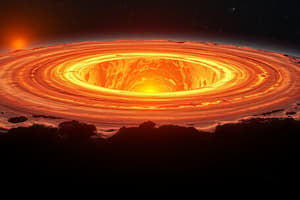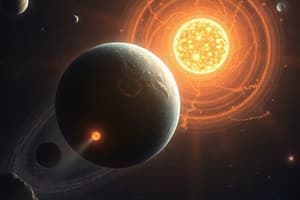Podcast
Questions and Answers
What are planetesimals?
What are planetesimals?
A small body from which a planet originated in the early stages of development of the solar system.
What are protoplanets?
What are protoplanets?
Some planetesimals joined together through collisions and the force of gravity to form larger bodies.
What is differentiation?
What is differentiation?
As Earth developed, denser materials such as molten iron sank to its center and less dense materials were forced to the outer layers.
What is outgassing?
What is outgassing?
Name the planets in order starting with the Sun.
Name the planets in order starting with the Sun.
Which planet does Ganymede belong to?
Which planet does Ganymede belong to?
Which planet has 4 rings?
Which planet has 4 rings?
Which planet is almost the same size as Earth?
Which planet is almost the same size as Earth?
What body is 109 times the diameter of Earth?
What body is 109 times the diameter of Earth?
What body takes 25 Earth days for it to be one day?
What body takes 25 Earth days for it to be one day?
Which body is 2,152 miles?
Which body is 2,152 miles?
Which body has no year?
Which body has no year?
Which planet takes 11.86 Earth years to revolve around the Sun?
Which planet takes 11.86 Earth years to revolve around the Sun?
Does the Moon have a strong magnetic field?
Does the Moon have a strong magnetic field?
What are the Moon's layers?
What are the Moon's layers?
What planet do Europa, Ganymede, Io, and Callisto revolve around?
What planet do Europa, Ganymede, Io, and Callisto revolve around?
What body is 1,000 km wide?
What body is 1,000 km wide?
What body is 6,800 km?
What body is 6,800 km?
What body is 3,760 km?
What body is 3,760 km?
What body is 1,516 km?
What body is 1,516 km?
What planet do Phobos and Deimos revolve around?
What planet do Phobos and Deimos revolve around?
What moon is 27 km?
What moon is 27 km?
What moon is 15 km?
What moon is 15 km?
What is the biggest asteroid ever discovered?
What is the biggest asteroid ever discovered?
What body has massive volcanoes and canyons?
What body has massive volcanoes and canyons?
What body is made up of 96% CO2?
What body is made up of 96% CO2?
What body takes 243 Earth days to rotate once?
What body takes 243 Earth days to rotate once?
What body takes 68 and 15 hours to rotate once?
What body takes 68 and 15 hours to rotate once?
What body takes 225 Earth days to revolve around the Sun?
What body takes 225 Earth days to revolve around the Sun?
What body takes 87.969 Earth days to revolve around the Sun?
What body takes 87.969 Earth days to revolve around the Sun?
What planet's interior composition is metallic?
What planet's interior composition is metallic?
What body is made up of 95% CO2?
What body is made up of 95% CO2?
Which moon is 2,985 miles and brownish grey?
Which moon is 2,985 miles and brownish grey?
Which moon is 3,100 km and white and tan?
Which moon is 3,100 km and white and tan?
Which moon is only half its mass and is a mix of brown and blue?
Which moon is only half its mass and is a mix of brown and blue?
Which moon is 2,263 miles and brown black red white yellow and green?
Which moon is 2,263 miles and brown black red white yellow and green?
Which two moons' day is equal to its year which is 42 hours for Io and 172 hours?
Which two moons' day is equal to its year which is 42 hours for Io and 172 hours?
Which moon's year is one more Earth day than its day (16 Earth days and year is 17 Earth days)?
Which moon's year is one more Earth day than its day (16 Earth days and year is 17 Earth days)?
Flashcards are hidden until you start studying
Study Notes
Solar System Formation
- Planetesimals: Small bodies that formed the building blocks of planets during the early solar system.
- Protoplanets: Larger bodies created from the collision and merging of planetesimals, forming the initial stages of planets.
Earth's Development
- Differentiation: The process wherein denser materials, like molten iron, sank to Earth's center, while lighter materials formed the outer layers.
- Outgassing: Volcanic activities released a variety of gases, including water vapor, carbon dioxide, nitrogen, methane, sulfur dioxide, and ammonia.
Planetary Overview
- Order of Planets: Mercury, Venus, Earth, Mars, Jupiter, Saturn, Uranus, Neptune, Pluto.
- Jupiter: The largest planet; has four distinct rings; Ganymede is one of its moons.
- Venus: Nearly the same size as Earth; composed mostly of carbon dioxide (96%); takes 243 Earth days to rotate; has a revolution period of 225 Earth days.
- Mercury: Smallest planet; 1,516 km in diameter; metallic interior; takes 68 hours and 15 minutes to rotate; orbits the Sun in 87.969 Earth days.
Celestial Bodies
- The Sun: 109 times the diameter of Earth; takes 25 Earth days for one rotation; does not have a year.
- The Moon: 2,152 miles in diameter; consists of three layers: crust, mantle, and core; has a weak magnetic field.
Mars and Its Moons
- Mars: Diameter of 6,800 km; features massive volcanoes and canyons; hosts two moons, Phobos and Deimos, which revolve around it.
- Phobos: Diameter of 27 km; has a rotation period equal to its revolution period.
- Deimos: Diameter of 15 km; longer year compared to its day.
Asteroids
- Ceres: The largest asteroid ever discovered, located in the asteroid belt.
- General Asteroids: Some asteroids can reach widths of up to 1,000 km.
Jovian Moons
- Europa: Diameter of 3,100 km; characterized by a white and tan surface.
- Ganymede: The largest moon; a mix of brown and blue; only half the mass of Earth’s Moon.
- Io: Diameter of 2,263 miles; known for its colorful surface, featuring brown, black, red, white, yellow, and green patterns.
- Callisto: Diameter of 2,985 miles; noted for its brownish-grey surface; has a day longer than its year (16 Earth days day; 17 Earth days year).
- Day-Year Synchronization: Io and Ganymede experience synchronized days and years, with periods of 42 hours for Io and 172 hours for Ganymede.
Studying That Suits You
Use AI to generate personalized quizzes and flashcards to suit your learning preferences.




